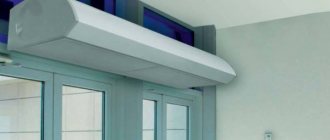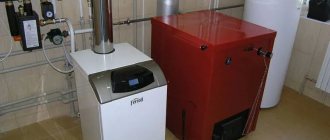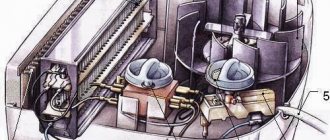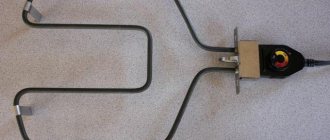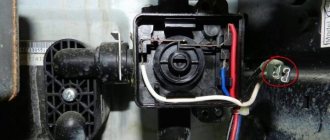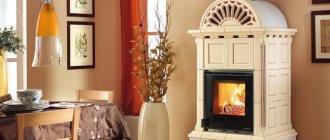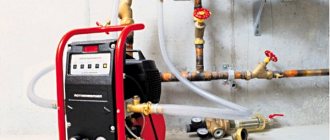A convector is a device accessible to many, with which you can easily create the most comfortable temperature in a room. The use of convectors has become widespread relatively recently. But even in such a short period of operation, the convector has earned a reputation as a reliable device. Today there are quite a large number of different types of convectors - ceiling, floor heating convectors, made of various materials. Let's look at how they are designed and how they work.
Heating convector
Heat sources
To heat a living space, a person uses different heat sources. The most common was hot water circulating in a closed kennel from pipes laid throughout the house.
But the water still needs to be heated before being fed into the pipes. For this purpose, centralized heat supply is used in multi-storey buildings.
In this case, there is a separate boiler plant, where combustion of gas or coal is used for heating.
In private homes, autonomous gas heating is more often used, where a small gas boiler is used to heat water, providing heat only to the house in which it is installed.
It’s just that with centralized heating, certain deadlines are set for providing heat to the house, and the heat supply itself wants to leave the best.
In the private sector, there are times when the house is cool and you don’t want to start the boiler.
In this case, electric heaters come to the rescue. Although they consume a significant amount of electricity, since they have significant power, they are able to quickly heat any room in the house.
There are a large number of types of electric heaters, from simple spiral heaters, popularly nicknamed “goats,” to modern infrared and convector heaters.
The latter are becoming increasingly popular these days.
Convector heater design
The electric convector is externally made in the form of a rectangular structure of small thickness, with a horizontally oriented grille on top of the front side, and another similar grille, but at the bottom of the back side.
The heater control unit is located at the end of the top or side part.
Inside the convector body there is a heating element with a diffuser, a control board and a temperature sensor.
Moreover, the heating element and diffuser are located in the lower part, and the board is located at the top. This is the whole filling of such a heater.
The control board additionally includes a thermostat that allows you to maintain the temperature in the room, as well as a fuse that controls the operating temperature of the device and provides emergency shutdown in case of overheating.
Designs of convector heaters.
Convectors use several heaters of different designs.
The simplest are needle-type heating elements. They have a plate on which a nickel thread is attached in the form of loops.
There are also tubular heating elements in which the heating element is located inside the tube.
The best are monolithic heaters that use a sealed tube filled with magnesite.
The diffuser consists of aluminum plates installed along the entire length of the heating element tube. Its task is to ensure better heat transfer by increasing the area of the heating element.
The temperature sensor is located near the bottom grill. The sensor itself is very sensitive and is capable of detecting a temperature change of even 0.1 degrees. WITH.
Choosing the best electric convector
The principles that will help you choose a convection heater for an apartment, cottage or house remain unchanged. Our goal is to choose, not illusively, the best electric convector, but a reliable device that will provide us with good warmth and take up a lot of space, and even better fit into the interior and become a unique highlight.
Step one
Heating power is the main characteristic of a convector. Traditionally, calculations are based on the conditions that 100 W are required for heating per 1 m2. Are you probably scared by the prospect of spending 1000 watts per hour to heat a 10 m2 room? But we are going to buy an electric convector for additional heating! Therefore, we safely advise you to buy a device with lower performance. For additional heating of 18 m2, 1 kW of power is quite enough, and even then, most likely you will use half the power.
Modern devices are equipped with step-by-step heating control. This way, it will be easier for you to select the required power at home, even if you decide to buy an electric convector with a “reserve”
Step two
Probably the most pleasant in our review, and it is dedicated to design. Of course, there are not many options for creativity, but still. Electric convectors can be found in traditional white colors and other colors, even mirrored options. We also select design solutions according to needs; the standard convector has the same height, around 45 cm, but varies in length depending on the power. In addition, there are interesting offers of flat models and a space-saving plinth convector.
Step three
A really important point is to decide on the thermostat in our device. The manufacturer completes products ranging from inexpensive mechanical sensors to expensive electronic ones. Electronic thermostats are the most accurate. A mechanical thermostat, on the one hand, is cheaper, on the other hand, it has low accuracy and is more susceptible to wear. The electronic device responds to a change of 0.1 degrees, in addition, it has the ability to be programmed.
Here we leave the choice of convector control up to you, since in the future, you can always buy an additional socket with a thermostat and expand the capabilities of your inexpensive device. Let us only add the unconditional fact that an accurate thermostat will contribute to the greatest energy savings.
Principle of operation
The operation of this heater is based on the ability of air to rise upward when heated.
In a convector, this property is implemented as follows: cold air located at the bottom of the room enters the convector through the lower grille.
Passing through the heating element with a diffuser, the air heats up and rises upward, where it exits through the upper grille.
Hot air rushes upward and displaces cooler air, which falls down and enters the convector.
In this way, air is circulated through the convector, which ensures constant heating of the air, and as a result, the temperature in the room.
Additionally, heat exchange is carried out by the convector body itself. The air, rising up inside the housing, heats it, and it subsequently gives off heat to the external environment.
This design is good because even with maximum heating, the walls of the case do not heat up too much, which ensures safety.
The temperature to which the air should be heated when passing through the convector heater is set on the control unit.
Advantages and disadvantages
Electric convectors have enough advantages. Its first and most important advantage is high efficiency; the convector provides this indicator at 95%.
In addition, positive qualities also include:
- Easy to install and use. All you need to do is place it next to the outlet, connect it to it and set the temperature;
- The design of such a convector is very simple, which ensures high reliability. The average service life of a convector is approximately 15 years. At the same time, it requires minimal maintenance - periodic cleaning of the device from dust;
- The presence of a thermostat in the design ensures automatic maintenance of the temperature in the room, without human intervention. When the desired temperature in the room is reached, it turns off. As soon as the temperature drops, the convector turns on. Moreover, the convector is guided by the temperature in the lower part of the room, that is, by the cold air. Therefore, the temperature sensor is located at the bottom of the convector;
- The design of such a convector has no moving parts, which ensures silent operation. The only source of noise can be a thermostat, made in the form of a mechanical relay. When activated, such a thermostat will create a clicking sound when the contacts close. Electronic thermostats do not make any sounds;
- These heating devices begin to provide heat to the room almost immediately after being plugged in, and are able to quickly heat the air in the room;
- Safety of use. Even at maximum performance, the heater body, which also participates in heat exchange, does not heat up to such a temperature that can cause a burn to a person. A fuse protects the device from overheating.
Flaws.
However, convector heaters also have disadvantages. Although they are few and far between, they exist.
So, the disadvantages of convectors include:
- Significant energy consumption. Although this indicator largely depends on the thermal insulation of the room. With strong heat losses due to drafts, poor insulation of walls and windows, energy consumption will be high, but if thermal insulation is at the proper level, energy consumption will not be particularly high;
- It will not be economically feasible to heat large rooms with convectors. They are more suitable for local heating. That is, they are best used either in small rooms or as a supplement to centralized heating;
- Convector heaters, although they do not heat the air to significant temperatures, still dry it out somewhat. Therefore, when using such devices, it is better to worry about air humidification in advance;
- Even without moving parts, the convector is capable of spreading dust throughout the room. It does this because the air circulates during its operation due to heating, and therefore moves small dust particles.
We recommend reading - how to choose electric heating boilers.
Tips for choosing a convector
When choosing a convector heater, we take into account its following characteristics:
- Power consumption;
- Type of heating element;
- Device dimensions;
- Operational safety;
- Additional features;
- Price;
- Manufacturer;
- Indicators during inspection.
1. So, power. It is selected based on the size of the room to be heated. For example, if you plan to use the device in addition to heating during the period when you are not heating it yet or are no longer heating it, then we calculate the power as follows: for each cubic meter of room volume you need 25 watts of power. But if there is no heating in the house at all, then you will have to calculate based on 40 watts per cubic meter.
Let's give an example: if the area of the room is 19 square meters, the ceilings are 2.7 tenths of a meter, we calculate the power of the heater in the off-season by multiplying these two values by 25. We get 1285.5 watts. We round up and look for a heater with a power of one and a half kilowatts.
2. Type of heating element. As for the heating element, if you have a choice, take a heater with a cast monolithic heater - it will last longer and work more efficiently.
3. Dimensions of the device. When inspecting the device, pay attention to its dimensions, especially its height. After all, it depends on it how fast the air will move. For example, low convectors with a height of only 60 centimeters are able to ensure very rapid movement of air masses and, accordingly, heat the room faster. It is also important how heavy the device is - after all, you may have to move it from place to place during use.
4. Operational safety. The heater must be as safe as possible. As a matter of fact, convectors are the safest heating devices. After all, their body only heats up to 60 degrees, no more, and therefore will not leave burns. Parents of small children prefer models in which the body has no corners and has smooth contours. Grounding is not necessary for convectors, and they can withstand voltage drops with flying colors.
5. Additional features. Among the additional features that a good convector has, the following can be noted:
- The temperature regulator is a very convenient thing. If it’s warm outside, you can turn it up a little, and if it’s very cold, set it to maximum.
- The thermostat will allow you to constantly maintain the temperature in the room that is most comfortable for you.
- The timer will make it possible to turn on the heater for a certain time, after which the shutdown device will operate. It’s a good idea to use this opportunity in the evening, before going to bed.
- The built-in ionizer absorbs dust, saturating the air with negative ions. It is very good for health. In a room with such a microclimate, you sleep better and work more productively.
- The remote control and on-timer will allow you not to get out from under a warm blanket in the morning to heat the room.
- Rollover protection is a very important feature, especially if you have playful animals or fidgety children in the house.
Mechanical control system.
Convector with electronic control system
6. When choosing a heater manufacturer, keep in mind that a good thing cannot be cheap. After all, we all want the heater to be efficient and safe, to work for a long time and to have normal warranty service. Therefore, when choosing a device, turn your attention towards well-known brands, whose guarantee is not just empty words. They are truly responsible for the quality of their products, which they have been producing for a long time and successfully selling them on the world market.
7. Visual inspection. When inspecting the convector offered by the seller in a store, take a good look at it for scratches or dents. Drips of paint, distortions of the body, nicks and sharp edges are unacceptable. Screws and bolts must not protrude from the housing. If you don’t like something or find it suspicious, it’s better not to buy such a heater. After all, this indicates either poor assembly or careless transportation.
Remember the following three rules: 1. Every convector type heater will dry the air in the room. There is simply no other option, according to the operating principle. The maximum that can help: a container of water for evaporation. 2. Since the air is constantly moving through the process of convection, dust will move along with it. Over time, it will accumulate between the plates. If a deceitful seller tells you that “only this model” of the convector does not accumulate dust, do not listen to these tales and call another consultant. 3. Any electric heater has an efficiency factor close to 100 percent. Therefore, do not believe that only this model, stubbornly imposed by the seller, can provide such efficiency.
Types of convector heaters
Structurally, all convector heaters are very similar, but several types are produced - wall-mounted, free-standing, floor-mounted and for rooms with high humidity.
They can be divided into high ones - with a height of up to 650 mm, and low ones - up to 200 mm.
Wall-mounted and free-standing are classified as high. The difference between them comes down to the fact that wall-mounted ones are equipped with lugs for mounting on the wall, making them stationary and providing heating only for the room where they are installed.
Free-standing - they have legs with wheels at the bottom, which allows them to be moved if necessary, providing warmth in different rooms.
A feature of this type of heaters is the high heating of the heating element, which, in combination with a high body, ensures high air circulation, which ensures their high thermal efficiency.
Floor heaters are made slightly differently, although their design is identical. They are not high, they are also called “plinth”.
But their width is much greater. Some models reach a width of 3000 mm.
Essentially, this is the same convector, but located horizontally. The large length and width, while its low location allows the heating elements to heat up less to achieve the required temperature, since they heat the lower layers of air more efficiently.
I often install such heaters under window openings.
The inconvenience of using floor heaters comes down to the same width. They take up more floor space, which leads to the possibility of frequent kicking.
Although some home owners, during construction, pre-allocate niches in the floor for installing such heaters, and then protect them with a grille.
Underfloor electric heating convector ESK series.
The types of convectors described above have one feature - they cannot be used in rooms with high humidity levels.
However, special versions of convectors are produced - waterproof. In such heaters, all internal elements are protected from moisture and can be used in any room.
Floor, wall and built-in convectors
Floor-mounted types of heating convectors are a very convenient solution. The advantage is mobility. After all, if necessary, you can move the device to any other room. But the downside is the power cord. Without a connection to the network, the convector will not be able to work - and in some cases the cord can become an obvious inconvenience (especially if there is a small child in the house).
The most common are wall-mounted heating convectors.
Their advantage is their small thickness. Such a convector can be installed under a window - this will create reliable protection against cold air entering the room. Wall-mounted convectors have an attractive design - they are almost invisible and do not spoil the overall appearance of the room.
Installation of heating convectors
Wall-mounted electric convectors
Built-in baseboard heating convectors are an ideal solution for large rooms. It is not profitable to install wall convectors in them, since they simply cannot heat a fairly large area.
The advantage of built-in convectors is that they can be laid into the floor in any area of the room - and then they will be able to cope with heating the room.
The only inconvenience is that planning for such a heating system is carried out during the construction of the building. After all, niches for convectors must be specially prepared in the floor, as well as channels in which the pipeline supplying hot coolant will be laid. Externally, built-in copper heating convectors will simply look like a beautiful grate in the floor, through the bars of which heated air rises into the room.
Floor-mounted heating convectors
In order to speed up the heating of a large room with a built-in convector, a device equipped with a powerful fan is often used. With its help, air circulation is carried out much faster.
An excellent solution for the home are fairly small built-in steel heating convectors. They are easily mounted under the baseboard, in the body of built-in furniture. Of course, this option is only suitable for electric convectors.
Choosing a convector heater
And the design of the convector seems to be clear, but choosing the right heating device is not so easy, since there are a large number of factors that influence the correct choice.
One of the factors that should be considered when selecting a convector is its type.
The most common are wall convectors. They are able to provide a good amount of heat to the room, since they are located directly on the walls.
They are often placed under window openings. This allows you to create a thermal curtain near potential sources of cold air when using a convector. But they are stationary.
If you need to create comfortable conditions in different rooms, then it is better to purchase a free-standing convector equipped with wheels for movement. It is convenient to drag such a convector from room to room; the only condition is that there is an outlet in the room.
Wall-mounted and free-standing convectors are often used as additional heating, although there is heating in the house that is fully provided by these devices.
Floor convectors are often used as the main heating in the house, and niches for installation are prepared for them at the planning stage of the house.
Review of models of popular convector manufacturers (characteristics, prices)
| Name | Characteristics | Description | |
| Power consumption, W | 2000 | The convector is equipped with a thermostat with a built-in function for remembering the last settings. The set also includes wheels that allow you to move the heater between rooms. |
| Heating power, kW | 1,0/2,0 | ||
| Recommended room area, m2 | up to 25 | ||
| Manufacturer country | China | ||
| Height, cm | 40 | ||
| Width, cm | 98,3 | ||
| Depth, cm | 11,9 | ||
| price, rub. | 4890 | ||
| Power consumption, W | 1000 | For maximum comfort in the room, this model has an air distribution system, and is also able to turn off when it overheats and tips over. |
| Heating power, kW | 0,5/1,0 | ||
| Recommended room area, m2 | up to 15 | ||
| Manufacturer country | Russia | ||
| Height, cm | 40 | ||
| Width, cm | 46 | ||
| Depth, cm | 11,3 | ||
| price, rub. | 2690 | ||
| Power consumption, kW | 3,0 | The advantage of this convector is that it has a heat exchanger made of high-quality steel with good fins, which significantly increases the heat transfer area. |
| Heating power, kW | 2,7 | ||
| Natural gas consumption, m3/h | 0,28 | ||
| Liquefied gas consumption, kg/h | 0,17 | ||
| Manufacturer country | Türkiye | ||
| Height, cm | 63,5 | ||
| Width, cm | 47 | ||
| Depth, cm | 27 | ||
| price, rub. | 13990 | ||
| Power consumption, kW | 2,17 | This model is very easy to use and does not require constant maintenance. Does not burn oxygen and operates silently. |
| Heating power, kW | 2 | ||
| Natural gas consumption, m3/h | 0,24 | ||
| Liquefied gas consumption, kg/h | 0,18 | ||
| Manufacturer country | Czech | ||
| Height, cm | 60 | ||
| Width, cm | 41,6 | ||
| Depth, cm | 21,5 | ||
| price, rub. | 35870 | ||
| Power consumption, kW | 4,5 | This convector is light, compact and most importantly - economical. |
| Heating power, kW | 4,5 | ||
| Liquefied gas consumption, kg/h | 0,24 | ||
| Manufacturer country | Sweden | ||
| Height, cm | 32 | ||
| Width, cm | 32,5 | ||
| Depth, cm | 34,5 | ||
| price, rub. | 3050 | ||
| Power consumption, kW | 0,7 | The installation of this convector-type infrared heater can be either floor- or wall-mounted. It also has an ergonomic design. |
| Recommended room area, m2 | 10 | ||
| Manufacturer country | Russia | ||
| Height, cm | 40 | ||
| Width, cm | 70 | ||
| Depth, cm | 5 | ||
| price, rub. | 3495 | ||
| Power consumption, kW | 2,0 | Infrared convectors are more economical than electric ones, they operate silently and no condensation forms during operation. |
| Recommended room area, m2 | 10 | ||
| Manufacturer country | Russia | ||
| Height, cm | 47 | ||
| Width, cm | 39 | ||
| Depth, cm | 8,5 | ||
| price, rub. | 8880 | ||
| Power consumption, kW | 0,1 | This convector is suitable for heating small rooms and can be used as both a main and an additional heat source. |
| Recommended room area, m2 | 1 | ||
| Manufacturer country | Russia | ||
| Height, cm | 40 | ||
| Width, cm | 44 | ||
| Depth, cm | 4 | ||
| price, rub. | 1430 | ||
Convector control
The second factor that is taken into account when choosing a convector is the type of control unit and thermostat. They are divided into mechanical and electronic.
The mechanical control unit is not a mechanical control unit; it simply includes a thermostat in the form of a regular contact relay. Therefore, it is mechanical - when triggered, the contacts are broken.
Convectors equipped with a mechanical control unit are cheaper because the temperature control is carried out by a mechanical regulator.
With such a regulator it is impossible to accurately set the temperature. They are also not very reliable and the regulator and thermostat may fail.
Electronic control units are much more convenient to use, since they allow you to accurately set the temperature regime.
It is controlled using keys, and the set temperature mode is displayed on a digital display.
There are devices equipped with a programmable control unit. In such convectors, the control unit allows you to set the daily operating mode of the device.
For example, until 10:00 am it will heat at one temperature, from 10:00 to 18:00 the temperature will decrease, and from 18:00 to 10:00 am the temperature will rise again.
Models are also produced in which control units can be connected into a single system.
They are usually used in rooms where only heating by convector devices is used.
Using such a system, with integrated control units, control the operating mode of all convectors from one control unit.
General characteristics
There are some parameters that are mandatory for all types of convectors. These include:
- thermostats - an electronic, programmable or mechanical temperature controller is certainly found on every modern convector. The main task of this element is to allow you to set the degree of air heating that will be as comfortable as possible.
- an electronic sensor is a simple and convenient element that significantly increases the safety of using the convector. In particular, all aluminum, steel, bimetallic heating convectors are equipped with an overheating sensor, that is, at the moment when the operating temperature of the convector is reached, the fuel supply (gas or electricity) is automatically turned off and the circulation of the coolant is stopped. After cooling, the operation of the device is also automatically restored. In addition, some models of electric convectors also have a tilt sensor. That is, the device will stop working if it is dropped.
- screen (air damper) - it can be stationary or mobile and allows you to adjust the direction of the flow of heated air.
Frame
When choosing a convector, you should also pay attention to the housing.
Firstly, you need to take into account the height of the device; the speed of air movement inside the housing depends on it, which ultimately affects the efficiency of its operation.
A convector with a height of 50 cm is considered optimal. This criterion also applies to floor convectors, but it is not its height that is taken into account, but its width.
Secondly, you need to take into account the thickness of the walls of the housing, because its walls also participate in heat exchange. Therefore, the thicker the walls of the housing, the higher the heat transfer will be, which means the efficiency of the device itself will be higher.
heating elements
Next you should pay attention to the heating elements. Needle-type heating elements, where the spiral is not protected by anything and is fixed on a thin plate, are very fragile; a small blow to the body is enough for the spiral thread to break.
But such convectors are much cheaper than with other types of heaters.
The most reliable and durable are monolithic heating elements. They are not afraid of shocks and can even withstand the device being tipped over. However, the cost of devices with heating elements is much higher.
The choice of monolithic heating elements is also supported by the operation of the convector itself.
Needle-type heaters may crackle slightly during operation, while monolithic heaters are absolutely silent.
Convectors with forced air circulation
In fact, these are ordinary steel, aluminum or bimetallic heating convectors, which are complemented by a fairly powerful fan. There are two main purposes of this element in the convector:
- more active air circulation - warm air rises much faster from the convector, and accordingly, the rooms warm up faster;
- cooling the heating element - the fan in this case acts as a kind of protection against overheating. And this can significantly increase the service life of the convector.
A striking example of a convector with a fan can be seen in almost every modern supermarket. Few people pay attention to the small openwork grilles around the perimeter of the hall. Meanwhile, a powerful stream of heated air rises from them, which heats the room.
Convectors with forced air circulation
Of course, the convector fan requires connection to the power supply. However, it consumes a fairly small amount of electricity, so you won’t see any significant waste. But the result will be noticeable.
Safety
An important factor when choosing a convector is the safety of its operation.
And although such devices are not capable of causing a burn to a person, since the body does not heat up to a traumatic temperature, there is, however, the possibility of accidentally tipping it over.
This is especially true for free-standing convectors.
To eliminate the possibility of a fire from a short circuit if accidentally tipped over, you should purchase devices equipped with a tip-over sensor.
This sensor, if the device overturns, will instantly de-energize it.
You should also take into account the weak level of electrical protection of devices with needle-type heating elements.
Install the heater and start using it
When you attach the convector frame to the wall or legs with wheels to the body, carefully follow the instructions - everything is described there. Maintain the required distances: the heater (that is, the lower edge of its body) should be no closer than 15 centimeters from the floor, and no closer than 25 centimeters from the wall or any object. As for the upper edge of the device, there should be nothing above it within 45 centimeters.
If you neglect these rules or cover the top slot with something, the case will quickly overheat, the protection will work and turn off the device. So, under no circumstances try to put a tall device under the window, do not dry things on its surface and do not cover its upper part with anything.
Caring for this type of heater is easy - you just need to wipe its outer panels with a damp cloth from time to time. Naturally, this is done when the device is unplugged from the outlet. Before doing this, check whether its body has cooled down sufficiently. To remove accumulated dust from the heating element, take a vacuum cleaner equipped with a short, narrow attachment and thoroughly clean the heating element.
Additional functionality
Many convector heaters are equipped with additional functions that can be very useful.
One of these functions is the additional equipment of the device with an ionizer.
In addition to heating, such a device will also purify the air, preventing the spread of pathogenic microbes.
An interesting thing is that the ionizer can work even when the convector does not perform its main function - heating.
But a device equipped with an ionizer can accumulate static electricity, so it requires grounding.
Another useful function is the so-called anti-freeze of the device. This function boils down to the fact that when the temperature in the room drops to a critically low level, for example, to +5 C, the device itself will turn on to increase the temperature in the room.
A very convenient function if you plan to be away from home for a long time.
In programmable convectors, a memory function for temperature settings can often be observed.
This function allows you to save all temperature settings and the device will start working with the specified parameters even after temporarily de-energizing it.
And this is only part of the additional functions that a convector heater can be equipped with.
Pros and cons of convector heating
The main advantages of this type of home heating:
- It is possible to heat rooms for a variety of purposes.
- There is no adverse effect on the air condition, since convector heating does not burn oxygen.
- Minimal impact on air humidity.
- Easy installation of heating equipment - this plus applies to electrical units.
- There is no negative impact on people's well-being.
- A wide range of equipment for the arrangement of heat supply.
In addition to the advantages, convector heating has disadvantages:
- The feeling of overheated air, which not all residents like.
- If the room has high ceilings, this type of heating will be ineffective.
- There is a big difference between the temperature in the upper layers of air and those located below.
As for electric convector heating, it has another big drawback - high cost. But not all houses have a gas main, and if there is a desire for the heat supply system to not require large expenses and be easy to install, then in this case it will not be possible to do without convectors.
Power calculation
Now about one of the most important criteria for choosing a convector heater - its power. After all, this parameter determines whether the device can provide the proper temperature in the room.
When calculating the required power of a device for heating a room, first of all you should decide how the convector will work - as an addition to central heating, or as the main source of heat.
You should also take into account the features of the room itself. In a corner room, or with a large glass area, you will need a device with increased power.
So, to heat a room of 10 square meters. The average value of the convector power is 1 kW. But this indicator is calculated for the average height of the room - 2.5-2.7 m. But this is if the convector is used as the main source of heat.
If it is in addition to centralized or autonomous water heating, then per 10 sq. m. 0.5 kW will be enough.
There is also a universal formula for calculating the power of a convector. Based on it, for every 1 cubic meter. The room should have 35-40 W of device power.
If the room is corner or has a large glass area, then an additional 15-20% of the power should be added to the calculated power of the convector required to heat the room.
Popular with readers: how to install an outlet in the bathroom.
Installation nuances
Installing an electric convector does not seem complicated; you can do it yourself or invite craftsmen, and you will not need permits from regulatory authorities. The only time when the help of certified specialists will be needed is in the case of an electric heating device with a load of more than 3-5 kW, since in this case an independent power line with protection will be required.
Before starting to operate such a heater, carefully study all the manufacturer’s instructions and comply with them, so that in the future there will be no problems with the warranty service of the device in the apartment.
Basic requirements for installing an electric convector:
- Select the installation location, it is prohibited to place the devices next to flammable or flammable objects, you will need to maintain a minimum distance: from the floor level for wall-mounted devices - 0.20 m, from any surrounding objects - 0.20 m on the side, 0.50 m - in front and above and to the socket - more than 0.30 mm.
- Floor stationary devices are secured to the floor with clamps. Wall-mounted ones are installed on brackets and extensions with fixing screws.
- Connect the device to the network after complete installation and transfer it to one of the operating modes.
Installation, adjustment and commissioning of a gas convector can only be performed by certified specialists, and commissioning of such equipment requires permits from the gas service.

